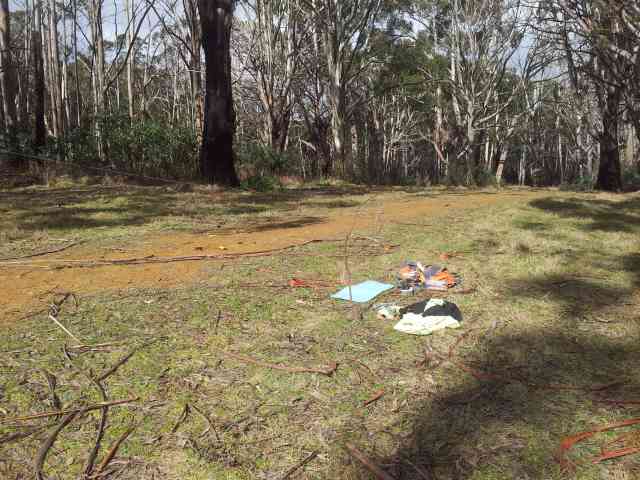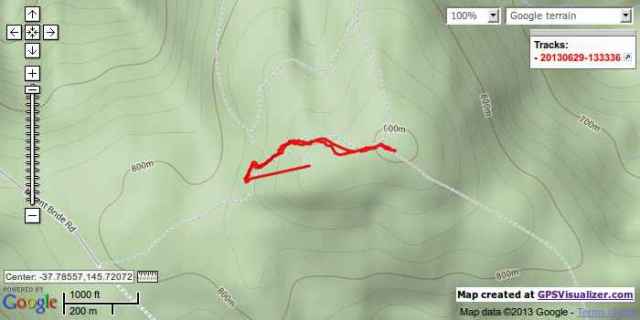My SOTA activations on HF use a vertical antenna which is all home brew. I decided on using a vertical because:
- I wanted an antenna that could be used anywhere, whether there were lots of trees or not.
- It needed to be able to be disassembled into segments no longer than 75cm in length so they could be put into a backpack. Some SOTA summits need significant off-track walking to access, and carrying a large 1m or more item outside the backpack – including being strapped on – was not a great solution for those situations.
- I wanted something with a low angle of radiation to work SOTA DX. Perhaps this would be at the cost of working local stations, but if the antenna was efficient enough I should still be able to work local, but get the DX as well.
Bunnings sell cyclical al in 10mm, 12mm and 16mm segments – and larger. By using the workshop at my radio club, I have cut these to size.
State of play in June
In June, I had a 6 summit activation long weekend in the Grampians. The final activation was at VK3/VW-007 Near Baroka Lookout. Allen, VK3HRA joined me for the second half of my activation. I was working 20m DX on CW while he worked 40m SSB. Some stations he worked had also worked me earlier on 40m, so I was very interested in his signal reports, which were generally about 2 points higher than mine. It’s not a contest about who has the best antenna, but when conditions are poor, a better antenna could be the difference between a successful activation or not, so it was time to do some work.
Allen was using a Buddistick with one radial. Now some get into the counterpoise vs radial wording thing, but at the end of the day it is about providing some kind of ground to minimise ground losses with a vertical. Now both our antennas were short for 40m, but mine was less short. I also had eight radials! So why the poor performance? His antenna was loaded, mine was unloaded. Answer: Rather than relying on an ATU to match the antenna because because of the short capacitive reactance, I needed a loading coil. Time to make one.
The Loading Coil
I like working multiple bands, and putting a loading coil on the antenna could restrict me to one band, and this would not do. The loading coil needed to be tapped, so I could bypass it, also select tapping points suitable for various bands. With 8 segments, the antenna is 6m long – longer than a 1/4 wave on 20, but short on 30 or lower. I used an online inductance calculator at Hamwaves, designing it on 50mm PVC pipe with a flat piece of aluminium to allow it to be screwed onto the antenna at one of the coupling points. I had already made up a piece of wood about 100mm long with two M8 screws at either end, so this was perfect to mount the coil. The coil would be long enough to have enough turns to resonant the antenna on 80m, as well as making tapping points lower down to resonant the antenna on 30 and 40.
My plan was to put the coil between segments 2 and 3 on the vertical, about 1.5m up from the feedpoint. On the net, and in NEC2 modelling I had done, having the loading coil up as much as possible is better, but it needed to be low enough that I could physically access it to change bands without needing to lower the antenna. I would still use an ATU, but this would be more about matching the resistance, rather than having to deal with all the reactance as well. A short antenna has a feedpoint resistance well below 50 ohms – even 1/4 wave is about 36 ohms, and shorter is lower. As the ground plane is improved, this resistance is lower than otherwise, leading to greater mismatch – but this is good because the missing resistance is missing ground losses. The job of the ATU is to match for this mismatch, but the losses across the ATU would be small.
First use in anger VK3/VC-003 Mt Richie
Now with my new loading coil, it was time to get it into action. Mt Richie was the first activation, with Mt Donna Buang VK3/VC-002 later in the day. Reports on 40m were a good two to three s points up on the usual, with many stations reporting that I had a good signal, rather than the usual “I’m digging you out of the noise”. So it looks like I’m better in the game. I could also tell during the setup that when I tapped the coil on 40m at a suitable tapping point – the radio was hearing a lot more signals. Loading a short antenna certainly seems the go.
One impact of the loading coil was that I could not use the antenna with 8 segments. The loading coil added enough weight that the antenna, despite 2 sets of guy ropes, could not stay up. I had to use the antenna with only 7 segments – 5.25m high from the feedpoint.
The Bunnings 10mm segments were just too weak and I needed something stronger. I had used 16mm segments for something else, but I was not that happy with how ridged it was either. I made up two 16mm steel segments with some 10mm aluminium tubing inside for the M8 threads. The 10mm tubing was held in place by a 6mm nut and bolt about 10cm up from the coupling. This has worked well in my experience, and makes the couplings stronger than other parts of the antenna. This approach would allow me to have a drop in replacement for the bottom 2 75cm segments on the vertical, and should get me back to an 8 segment antenna with the loading coil.
Rubicon forest triple activations
A few weeks after Mt Richie and Mt Donna Buang, I was activating three summits, Mt Bullfight VK3/VN-002, Pyramid Hill VK3/VN-005 and Bill Head VK3/VN-004. Conditions were poor on 40m to say the least, with a large skip zone during the day and attenuation on hops on 40 during the day high. If it was not for the loading coil, I would have not got away with the points from the three summits that day – as described in by blog post. I might not even got a single contact on some of those summits.
By now, I had used the stronger steel segments down the bottom of the vertical, and these had made the antenna structurally sound. There was no buckling anywhere lower on the antenna, which was the reason it used to fall over.
While conditions were poor, and a few days later, Peter VK3PF only got two contacts from VK3/VT-003, underlying the challenge, it made me think that things are still not quite right.
Further improvements
I had always not put the ATU actually on the feedpoint, but somewhere on the ground nearby. This was because the antenna would not be able to bear the weight of the ATU – it does not weigh much, but I was always struggling with the structural integrity of the antenna. My two steel segments seemed to have resolved that problem, so now I have begun to think it is time to put the ATU directly at the feedpoint.
When I first started doing portable activations with this antenna last year, I first had a 10m run of coax from the ATU to the feedpoint, with the radio near the ATU. It is convenient, but performance was terrible. I then had a short, 1m bit of coax from the feedpoint to the ATU, and then a longer run to the radio. This worked better. It does not significantly matter how long the run is from the radio to the ATU. It is all about what is between the ATU and the feedpoint and coax here is bad.
So I built up some homemade twin line from enamelled 1mm wire I had available. The run was 4 metres long. It was this length because another vertical I had been using has a feed point 1.5m off the ground. Even with my 8 segment vertical with a feed point 30cm off the ground, the 4 metres of twin line worked much better than 1 metre of coax. There was nothing wrong with the coax – I could use it quite happily between the radio and the ATU!
Still, the antenna is unbalanced and so is the tuner, and twin line is a balanced transmission line, so running an unbalanced signal down it must not be good. I built two Guntella 1:4 baluns, one to go at the tuner, and the other at the feedpoint. This further improved things – there was evidence before of RF at the radio, and these baluns removed it, also my RX was much better – further evidence of common mode currents before. One time I forgot a balun, and using the setup without them was certainly worse than what I was used to.
Reading W2FMI Jerry Sevick’s Transmission Line Transformers made me think that I still have not got this thing quite right. The Loading Coil gets rid of capacitive reactance, but it can not be said that there is 50 ohms on one side of the balun and 200 ohms on the other. This would mean that the losses of 0.05db that I had measured using a network analyser on these baluns would not be the case because of these mismatches. Over the Gippstech weekend, I did some Keith Roget activations at 100 watts in Morwell National Park and Tarra-Bulga National Park. The baluns got warm. Not hot, but the hotter one had it’s temperature raised about 20 degrees. This tells me that the loss is much greater than 0.05db, more like about 2 to 3db. There are two of these baluns, so there is 4 to 6db of signal improvement waiting to be taken.
So my current plan of attack is to do the following:
- Put the ATU directly on the feedpoint of the antenna, now that the steel segments have removed the instability problems. Get rid of the twin line and the two baluns. The ATU is unbalanced, feeding an unbalanced antenna.
- There will be some common mode currents reintroduced because the baluns are gone, and we do not want these. We certainly do not want them anywhere near the radio, but across the ATU is not such a big deal. So a 10 turn on 50mm PVC pipe Ugly Balun with coax – which is really a 1:1 unun will do the trick.
This Ugly Balun will get rid of the common mode currents that run on the outside of the shield, but because it is made of coax, the inner conductor and the inner surface of the shield are unaffected. There will be enough reactance on the Ugly Balun to block common mode currents even at 80m, but not too many turns to not work at 10m. Being on the radio side of the ATU – but right next to the ATU, means that the RF inside is going along a matched transmission line with low SWR, so the loss of this Ugly Balun should be very low.
That’s the plan, we’ll see how it goes at the next activation.
Regards, Wayne VK3WAM







You must be logged in to post a comment.